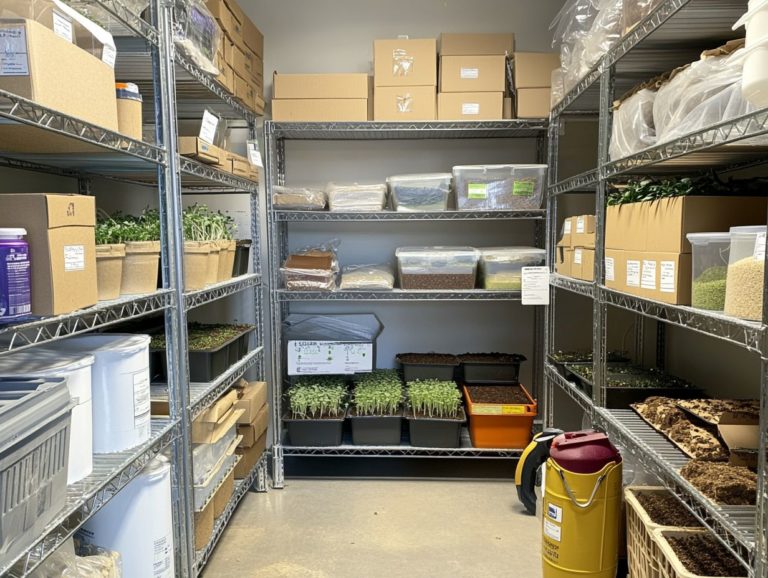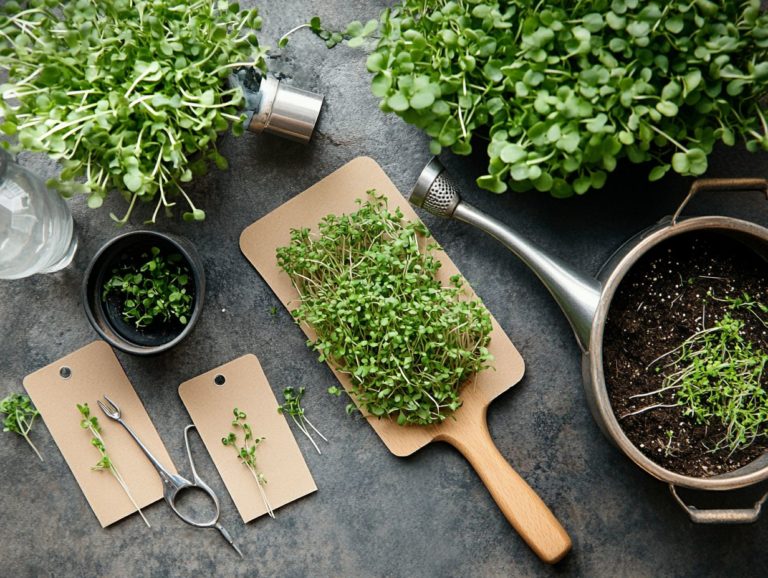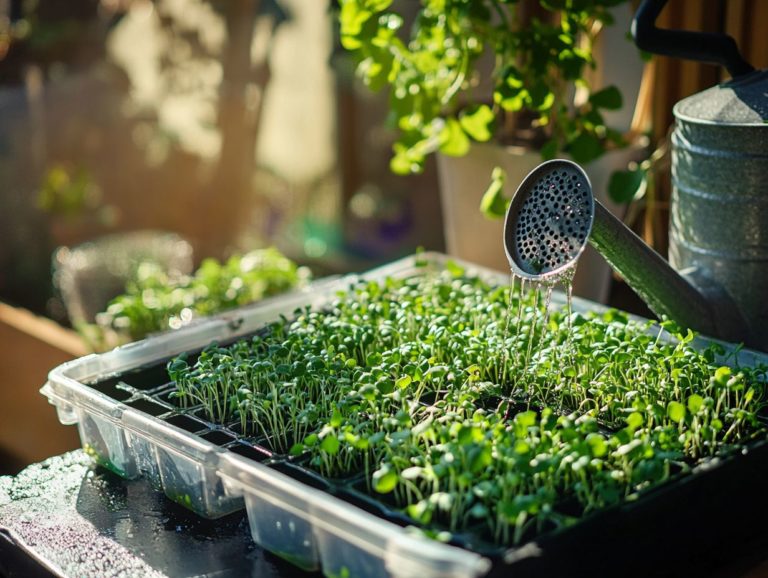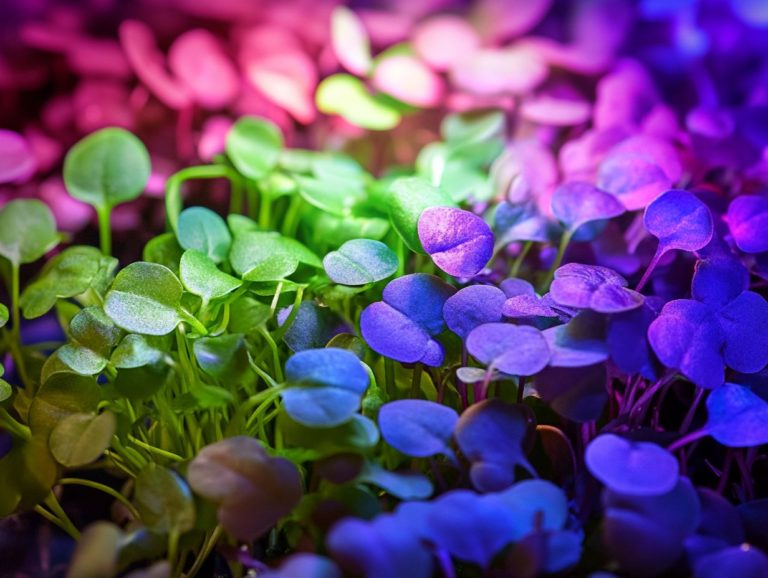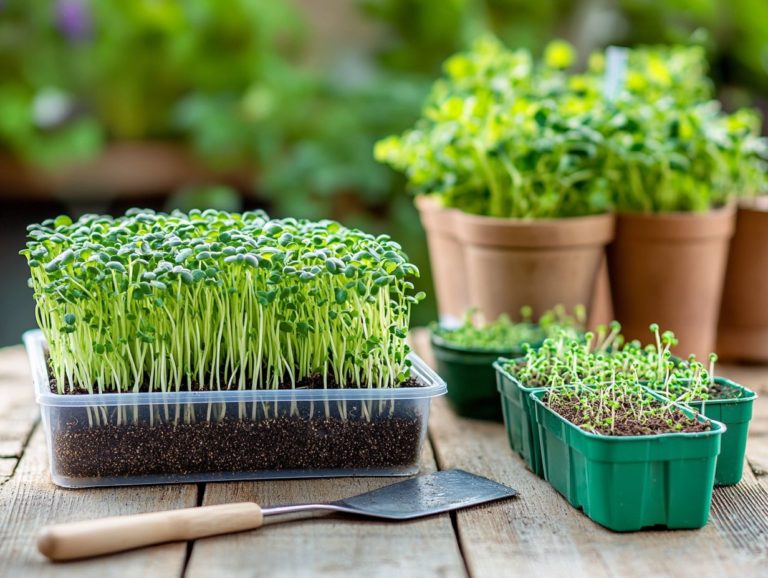5 Best Organic Pest Control Products for Microgreens
Maintaining healthy microgreens can be both a rewarding and challenging endeavor, particularly when it comes to managing pests. Get ready to discover five amazing organic pest control products that will keep your microgreens safe and thriving!
This guide will help you protect your greens without resorting to harsh chemicals. You’ll also explore the advantages of organic methods, the potential risks associated with chemical alternatives, application techniques, and additional natural pest control strategies. Dive in to cultivate a thriving microgreen garden!
Contents
- Key Takeaways:
- 1. Neem Oil
- 2. Diatomaceous Earth
- 3. Spinosad
- 4. Pyrethrin
- 5. Bacillus Thuringiensis (BT)
- What Are the Benefits of Using Organic Pest Control Products for Microgreens?
- What Are the Potential Risks of Using Chemical Pest Control Products for Microgreens?
- How Do These Organic Pest Control Products Work to Protect Microgreens?
- What Factors Should Be Considered When Choosing an Organic Pest Control Product for Microgreens?
- Conclusion
- How Can These Organic Pest Control Products Be Applied to Microgreens?
- What Are Some Other Natural Methods for Controlling Pests in Microgreens?
- Frequently Asked Questions
- What are the 5 best organic pest control products for microgreens?
- How does neem oil help control pests in microgreens?
- What is diatomaceous earth and how does it control pests in microgreens?
- Why is garlic spray a good organic pest control option for microgreens?
- How does insecticidal soap work as a pest control product for microgreens?
- Can using predatory insects be an effective form of organic pest control for microgreens?
Key Takeaways:
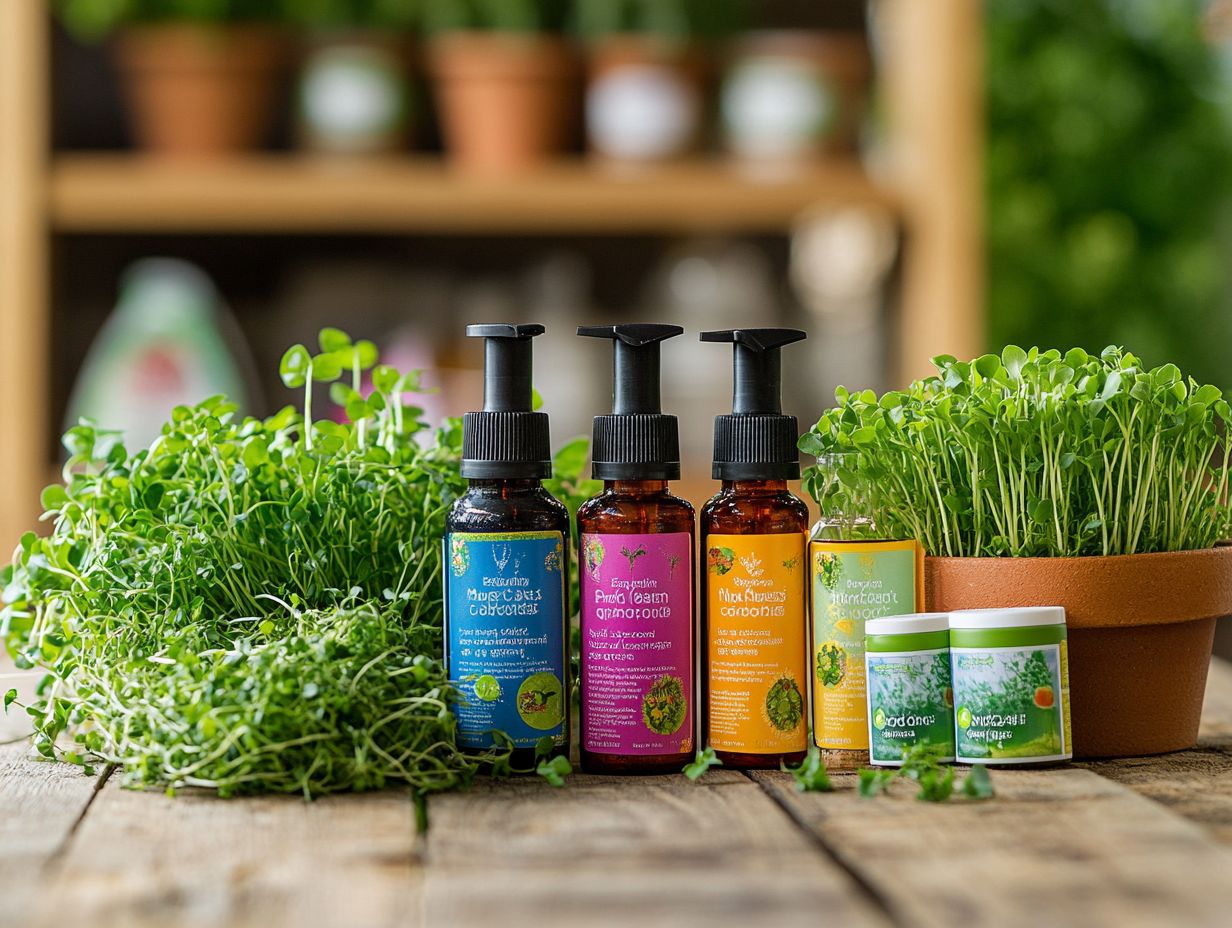
- Organic pest control products, such as neem oil and diatomaceous earth, offer safe and effective alternatives to chemical pesticides for microgreens.
- These products work by targeting specific pests without harming beneficial insects or polluting the environment.
- When choosing an organic pest control product for microgreens, consider factors such as the type of pest, application method, and potential risks.
1. Neem Oil
Neem oil stands out as a powerful organic pest control solution, expertly derived from the seeds of the neem tree. It s renowned for effectively tackling a wide range of common pests and diseases that can plague both indoor and outdoor gardens, including microgreens.
It simultaneously promotes healthy plant growth and resilience within the garden ecosystem. This natural extract helps manage issues like fungus gnats and powdery mildew. It minimizes harmful effects on your plants without using synthetic chemicals.
To use neem oil effectively, you ll typically want to dilute it at a ratio of 1-2% with water, ensuring thorough mixing before application. Always perform a patch test on a small area of the plant first to sidestep any unwanted reactions.
For an added boost, combining neem oil with potassium bicarbonate significantly enhances its antifungal properties, elevating plant health and vitality. This powerful synergy aids in controlling existing infestations while acting as a deterrent against future outbreaks, fostering a flourishing garden environment.
2. Diatomaceous Earth
Diatomaceous Earth (a powder made from fossilized algae) is your go-to, eco-friendly solution for pest control, targeting pesky invaders like ants, cockroaches, and aphids by dehydrating them on contact. If you’re practicing organic pest control in your microgreens or larger gardens, this is an essential tool you won t want to overlook.
This remarkable powder is made up of tiny, fossilized algae known as diatoms. Their sharp edges can puncture insect exoskeletons, leading to a swift dehydration process. It’s especially effective against soft-bodied pests, and its physical properties ensure it remains potent even in dry conditions.
To apply it, simply dust a thin layer around affected plants, making sure to cover surfaces where pests love to hang out. While Diatomaceous Earth is non-toxic to you and your pets, it s wise to wear a mask and gloves during application to avoid inhaling those fine particles.
For an even more effective pest management strategy, consider combining Diatomaceous Earth with traps and natural insect repellents. This approach will help you create a comprehensive defense against unwanted guests in your garden.
3. Spinosad
Spinosad is a naturally derived insecticide that specifically targets the nervous systems of pests, making it an exceptional choice for organic pest control. You can manage infestations in your microgreens and other indoor or outdoor gardens without worrying about harming beneficial insects.
This unique action disrupts the normal function of pests’ nerve cells, leading to paralysis and, ultimately, death. Its application is particularly advantageous for microgreens, effectively tackling common pests like aphids and thrips without causing damage to those delicate plants.
Rest assured, Spinosad is safe for you and your pets when used as directed, providing peace of mind while you cultivate your food. Combining Spinosad with other organic treatments, such as neem oil or insecticidal soaps, enhances its effectiveness. This creates a more robust pest management strategy that minimizes your reliance on synthetic alternatives.
4. Pyrethrin

Pyrethrin, derived from the delicate petals of chrysanthemum flowers, is a powerful organic pest control agent. It swiftly eliminates a wide range of pests while remaining safe for your indoor microgreens and outdoor gardens. This promotes optimal plant growth and health.
This natural insecticide works by targeting the nervous systems of pests, leading to paralysis and, ultimately, their demise. It’s particularly effective against common nuisances like aphids, whiteflies, and spider mites. One remarkable feature of pyrethrin is its rapid breakdown in the environment, which helps minimize long-term ecological impacts.
When incorporating pyrethrin into your gardening routine, follow recommended safety precautions. Wearing gloves and avoiding use during windy conditions will help protect beneficial insects and wildlife.
Integrating pyrethrin into a comprehensive organic pest management strategy shines even brighter. It’s especially effective when combined with practices like crop rotation which means alternating different types of crops in a specific area and the introduction of natural predators.
5. Bacillus Thuringiensis (BT)
Bacillus Thuringiensis, or BT, is a remarkable naturally occurring bacterium that serves as a highly effective organic pest control agent. It is especially good against pesky caterpillars and other larval nuisances. This makes it an invaluable ally in your quest to maintain healthy microgreens and prevent the spread of fungal diseases.
This beneficial bacterium releases proteins that specifically target the gut of certain insects. This ultimately leads to their demise while leaving beneficial insects completely unharmed. Its safety profile is impressive; BT is considered non-toxic to humans, pets, and the environment, making it an excellent choice for the conscientious gardener.
To apply BT effectively in your indoor gardening, mix it with water and spray it directly onto the affected plants during the evening when pollinators are less active. This method not only promotes immediate pest control but also aligns with sustainable gardening practices by minimizing chemical inputs and enhancing the overall health of your ecosystem.
What Are the Benefits of Using Organic Pest Control Products for Microgreens?
Utilizing organic pest control products for your microgreens offers numerous benefits. These include improved plant health, a lower chance of chemical residues, and effective management of common pests and diseases. This approach ensures a sustainable and safe growing experience for both your indoor and outdoor gardens.
By prioritizing natural solutions, you not only nurture robust plants but also play a vital role in environmental preservation. Organic pest control methods, like neem oil and diatomaceous earth, deliver targeted action against harmful insects while promoting a balanced ecosystem.
Choosing organic solutions significantly reduces the risk of harmful residues in your edible microgreens. This makes them a safer option for consumption especially for families with children. A holistic cultivation approach aligns with eco-friendly practices, ultimately elevating your overall gardening experience.
Try incorporating these organic methods into your gardening routine today for healthier plants and a happier environment!
What Are the Potential Risks of Using Chemical Pest Control Products for Microgreens?
Chemical pest control products may be effective, but they come with a laundry list of risks when applied to microgreens. You could inadvertently harm beneficial insects and leave chemical residues on your edible plants. Additionally, these products negatively impact soil health, jeopardizing the integrity of your indoor and outdoor gardens.
Many of these substances contain harmful chemicals, such as chlorpyrifos and neonicotinoids. These chemicals are linked to serious health issues in humans, including neurological disorders and various cancers. These chemicals can also leach into waterways, disrupting ecosystems and endangering aquatic life.
To navigate these pitfalls, explore safer alternatives like insecticidal soaps and neem oil. These options are significantly less harmful to both insects and humans. Embracing organic methods, such as companion planting and introducing natural predators, enhances sustainability and fosters a healthier growing environment.
By doing so, you ensure that your microgreens remain free from harmful toxins while promoting biodiversity!
How Do These Organic Pest Control Products Work to Protect Microgreens?
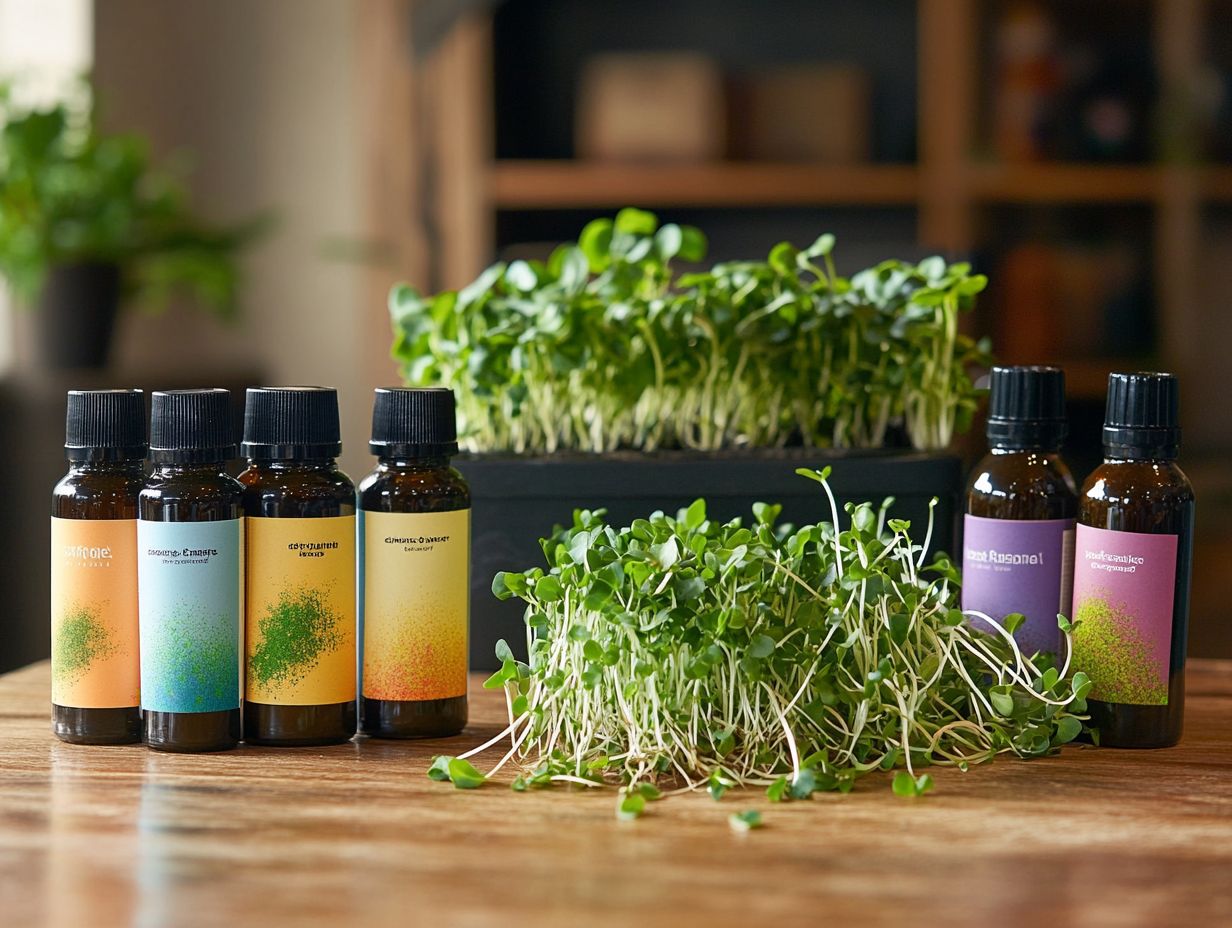
Organic pest control products work through impressive mechanisms to safeguard your microgreens. They disrupt pest life cycles, create protective barriers, and deliver targeted treatments that effectively manage pests and diseases all without harming your plants or the ecosystem.
Take Neem Oil, for example. It’s a powerhouse that repels pests and inhibits their feeding habits, making it particularly effective against pesky aphids and spider mites. Then there’s Spinosad, derived from natural sources and renowned for targeting chewing pests like caterpillars and thrips. It offers rapid results while remaining safe for beneficial insects!
Bacillus Thuringiensis operates on a microbial level, producing toxins that specifically target certain larvae, minimizing damage without impacting other insects. Through these various approaches, these products not only control pest populations but also enhance overall plant resilience, promoting stronger growth and healthier yields in a truly sustainable manner!
What Factors Should Be Considered When Choosing an Organic Pest Control Product for Microgreens?
When selecting an organic pest control product for your microgreens, consider several key factors. Think about the specific pests and diseases you aim to target, the product’s safety for both humans and beneficial insects, and how it fits with your overall gardening approach.
Understanding the life cycle of various pests is crucial; this knowledge informs your timing for applications and influences effectiveness. The frequency of application will vary among products. Some may require multiple treatments over a short span, while others might provide longer-lasting protection with less frequent use.
It’s also important to assess the environmental impact of your choices. Some organic solutions may support beneficial insects better than others. A careful comparison of various organic options will reveal their strengths and weaknesses!
For instance, Neem oil is quite effective against a range of pests but can be harmful to pollinators, while insecticidal soap delivers a quick knockdown of soft-bodied insects but may necessitate frequent reapplication to maintain its effectiveness.
Conclusion
In summary, exploring organic pest control options can lead to healthier gardening practices for your microgreens. Consider these alternatives today and protect your plants while promoting sustainability!
How Can These Organic Pest Control Products Be Applied to Microgreens?
Applying organic pest control products to your microgreens requires a thoughtful approach to timing, method, and concentration. This ensures maximum effectiveness while minimizing any negative impact on plant health and growth.
The method you choose can greatly affect the success of your pest management efforts. For example, foliar sprays allow for rapid absorption. It s best to apply them during cooler hours to avoid leaf burn.
Soil treatments, on the other hand, provide a lasting effect by targeting the root zone where pests tend to lurk. Always follow the manufacturer s instructions closely to prevent over-application. Conducting a patch test on a small area beforehand can help identify any potential adverse reactions.
Always prioritize safety; wear protective gear, ensure proper ventilation, and keep the application area clear of children and pets. By taking these precautions, you can create a thriving environment for your microgreens while effectively managing common pests and solutions for microgreens.
What Are Some Other Natural Methods for Controlling Pests in Microgreens?
You can also use natural methods such as companion planting, crop rotation, and encouraging beneficial insects to manage pests in your microgreens. These techniques help maintain a balanced ecosystem in both your indoor and outdoor gardens.
These methods reduce reliance on synthetic chemicals and promote biodiversity, paving the way for healthier plant growth. For instance, planting marigolds alongside your microgreens can deter aphids and nematodes. Additionally, basil is known to repel thrips and flies. To get the most out of your harvest, consider following the 5 best practices for harvesting microgreens.
Practicing crop rotation disrupts pest life cycles, diminishing their populations over time. Attracting beneficial insects like ladybugs and lacewings introduces a natural predation effect, further reducing pest numbers.
By implementing these strategies, you enhance the overall health of your garden and complement the effectiveness of organic pest control products, creating a more resilient growing environment.
Frequently Asked Questions

What are the 5 best organic pest control products for microgreens?
The top 5 organic pest control products for microgreens are neem oil, diatomaceous earth, garlic spray, insecticidal soap, and predatory insects such as ladybugs.
How does neem oil help control pests in microgreens?
Neem oil is a natural insecticide derived from the neem tree. It disrupts the insect’s hormonal system, causing them to stop feeding and reproducing. It is effective against a wide range of pests commonly found in microgreens.
What is diatomaceous earth and how does it control pests in microgreens?
Diatomaceous earth is a powder made from the fossilized remains of tiny aquatic organisms. It works by physically piercing and dehydrating insects, ultimately causing them to die. It is safe to use on microgreens and effective against various pests.
Why is garlic spray a good organic pest control option for microgreens?
Garlic contains natural compounds that repel and kill insects. When diluted and sprayed on microgreens, it can deter pests and protect the plants. It is also safe for consumption, making it a great option for growing edible microgreens.
How does insecticidal soap work as a pest control product for microgreens?
Insecticidal soap is specifically designed to kill insects. It suffocates pests and disrupts their cell membranes. It is safe to use on microgreens and can effectively control pests without harsh chemicals.
Can using predatory insects be an effective form of organic pest control for microgreens?
Yes, using predatory insects such as ladybugs or lacewings can effectively control pests in microgreens. These insects feed on pests and help keep their populations in check. They are a natural and safe option for pest control in microgreens.
Discover how you can protect your microgreens with these organic methods! Act now to create a thriving garden!

